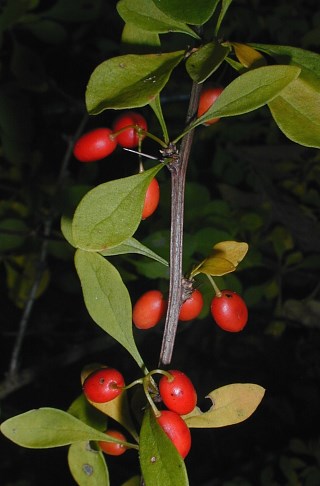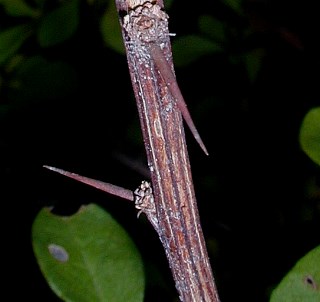Description:
This
woody shrub is usually 1-3' tall, although sometimes it
becomes up to 6' tall. This shrub produces abundant branches that are
widely spreading to erect. Alternate individual leaves, or alternate
clusters of leaves, occur at intervals along these branches. There is
often a solitary thorn underneath each leaf or cluster of leaves; these thorns persist after
the leaves fall from the branches. Twigs and young branches are brown,
angular, and ridged. Older branches are striped with different shades
of brown, while the oldest branches of large shrubs have rough grey
bark. Individual leaves are are up to 1¼" long and about 1/3 as much
across; they are oblanceolate to obovate, smooth along their margins,
and hairless. The upper surfaces of the leaves are medium to dark
green, while their lower surfaces are light to medium green. About 1-5
flowers develop from the axils of the leaves or clusters of leaves;
these flowers are arranged in drooping umbels that develop from short
stalks (peduncles). Individual flowers span about ¼" across, consisting
of 6 petal-like sepals, 6 petals, 6 stamens, and a single pistil. Both
the petals and sepals are pale yellow; the sepals are widely spreading,
while the petals form an inner cup that surrounds the reproductive
organs of each flower. The blooming period occurs from mid- to late
spring. Fertile flowers are replaced by ovoid berries containing a few
seeds; these berries are bright red at maturity, about 1/3" (8 mm.) in
length,
and they have a rather dry mealy texture. The root system is woody and
branching. If the tips of branches become lodged in moist soil,
vegetative offsets can develop. Otherwise, Japanese Barberry spreads to
new areas from the seeds in its fruit. Sometimes, this shrub forms
thorny colonies.
underneath each leaf or cluster of leaves; these thorns persist after
the leaves fall from the branches. Twigs and young branches are brown,
angular, and ridged. Older branches are striped with different shades
of brown, while the oldest branches of large shrubs have rough grey
bark. Individual leaves are are up to 1¼" long and about 1/3 as much
across; they are oblanceolate to obovate, smooth along their margins,
and hairless. The upper surfaces of the leaves are medium to dark
green, while their lower surfaces are light to medium green. About 1-5
flowers develop from the axils of the leaves or clusters of leaves;
these flowers are arranged in drooping umbels that develop from short
stalks (peduncles). Individual flowers span about ¼" across, consisting
of 6 petal-like sepals, 6 petals, 6 stamens, and a single pistil. Both
the petals and sepals are pale yellow; the sepals are widely spreading,
while the petals form an inner cup that surrounds the reproductive
organs of each flower. The blooming period occurs from mid- to late
spring. Fertile flowers are replaced by ovoid berries containing a few
seeds; these berries are bright red at maturity, about 1/3" (8 mm.) in
length,
and they have a rather dry mealy texture. The root system is woody and
branching. If the tips of branches become lodged in moist soil,
vegetative offsets can develop. Otherwise, Japanese Barberry spreads to
new areas from the seeds in its fruit. Sometimes, this shrub forms
thorny colonies.
Cultivation:
This shrub adapts to a wide range of conditions. It can be found in
full sun to medium shade, moist to dry conditions, and different soil
types. The seeds have a high germination rate. Unlike other Berberis
spp. (Barberries) that have naturalized in Illinois, Japanese
Barberry is resistant to wheat-stem rust.
Range & Habitat:
Japanese Barberry is occasional throughout Illinois; it is more common
in central and northern Illinois than in the southern section of the
state (see Distribution
Map). Populations of this shrub within the state are probably
increasing. It was introduced into North America from Japan as an
ornamental shrub. In the
United States, various cultivars are available for gardens and
landscaping, even though this shrub is invasive in some areas. However,
cultivars with yellow to red leaves are less vigorous and they don't
appear to escape into natural areas to the same extent as green-leaved
cultivars. Habitats of escaped shrubs include open woodlands, woodland
openings, woodland borders, thickets, savannas, meadows, pastures, and
roadsides. Usually this shrub is found in mesic to dry areas that are
open to semi-open, although it also occurs in moist shady woodlands.
Faunal Associations:
The flowers attract small insects with nectar and pollen; such visitors
trigger an inward movement of the stamens that coats them with pollen.
Insects that feed on the foliage of Berberis spp.
(Barberries) include Liosomaphis berberidis
(Barberry Aphid) and the caterpillars of the moth Coryphista
meadii (Barberry Looper). The Ruffed Grouse, Ring-Necked
Pheasant, Wild Turkey, and possibly other birds eat the berries; this
helps to spread the seeds into new areas. The toxic foliage and thorny
twigs are not eaten by White-Tailed Deer. Consequently, when these
animals become common in a woodland area, this shrub tends to increase
in abundance. Sometimes birds build their nests in this thorny shrub as
it provides good cover and protection from predators.

Photographic
Location:
Along a path in an upland woodland in McLean County, Illinois.
Comments:
Three Berberis spp. (Barberries) can be found in
natural areas of Illinois: Berberis thunbergii
(Japanese Barberry), Berberis vulgaris (European
Barberry), and Berberis canadensis (American
Barberry). Among these three species, only Japanese Barberry has leaves
with smooth margins; the other species have leaves with toothed
margins. Japanese Barberry has individual thorns along its branches,
while the thorns of European Barberry and American Barberry are more
often branched, producing 1-3 thorns in a cluster. The only native
species, American Barberry, is very rare in Illinois; it is more common
in the Appalachian mountains.